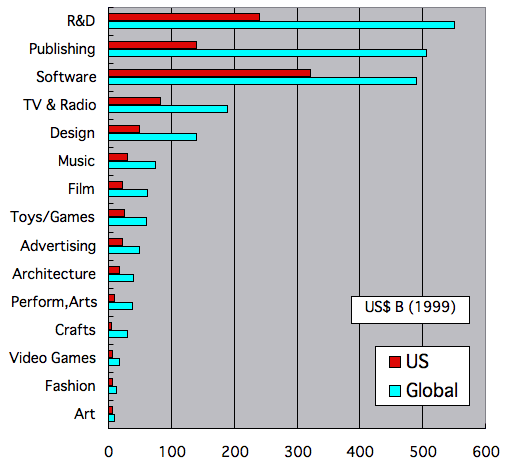Creative Cities
Developments
|
Cat: ICT |
|
Larry M. Kubota |
06216u/18126r |
Title
Creative Cities Developments in Global Media Cities
グローバルメディアシティにおけるクリエイティブシティの発展
Author
Larry M. Kubota
ラリー・M・クボタ
Published
2006
2006年
Index
Why?
- Dr. Larry M. Kubota is CEO & Founder, Black Current Productions,
Ltd., Visiting Professor, Institute of Innovation Research, Hitotsubashi
Univ., and Fellow,Glocom, International Univ. of Japan.
- This is a memo at the study group of The Japanese Institute of
Global Communications (J.I. Glocom) presided by Prof.Takahiro Miyao
on Feb.10, 2006.
- Dr.ラリー・クボタは、一橋大Innovation Research研究所客員教授で、国際大学Glocom Fellow.
- 本メモは2006年2月10日の国際大学情報発信機構宮尾尊弘教授主催の研究グループでのメモである。
Summary
要約
>Top
0. Preface:
- Industrial Economy is giving way to the Creative Economy.
- US Capital spending on IT increased from 10% in 1960 to 35%
in 2000.
- Workers in industry in the US will fall below 20%.
- Idea based corporations have easy access to capital.
- Most important intellectual property isn't software or music
or movies, it is what is inside people's heads.
0.序:
- 産業経済はクリエイティブ経済に取って代わる。
- 米国のIT投資は10%/1960年から35%/2000年へ
- 米国の産業労働者は20%以下へ
- 頭脳依存企業は資金調達が容易
- より重要な資産はソフトウェアでも音楽でも映画でもない。それは人々の頭の中にある。
>Top
1. Core Industries of the Creative Economy:

1.クリエイティブ経済の中心産業:
- By market size in US$ B (1999)
- R&D
- Publishing
- Software
- TV & Radio
- Design
- Music
- Film
- Toys & Games
- Advertising
- Architecture
- Perform, Arts
- Crafts
- Video Games
- Fashion
- Art
>Top 2. Rise of the Creative Class:
- Scientist, engineer, architect, designer, writer, artist, musician,
or those using creativity in their work in business, education,
law or health care.
- US: 38 M members, 30% of the workforce.
- Basis of creative class in economic.
2.クリエイティブ階級の登場
- 科学者、エンジニア、デザイナー、著者、芸術家、ビジネス・教育・法律・医療等の専門家
- 米国では38M人、労働人口の30%
>Top 3. Creative Places:
- Large cities and regions
- variety of economic opportunities
- stimulating environment
- amenities for many possible lifestyles
- "Geography of Cool"
- center of artistic & cultural activity
- active, informal, street-level amenities
- clubs, cafes, cutting-edge music scene
- "Media Cities"
3.クリエイティブな場所
- 大都市・周辺
- クールな場所
>Top 4. Creative Cities:
- Creative Cities drive the economy.
- Globalization produces new rankings of cities - "Global Cities"
- Some high-ranking Global Cities do not rank high as Global Media
Cities
- Ranking Global Media Cities are mainly Western.
- Profound influence on production and dissemination of media and,
thereby, "culture"
4:クリエイティブ・シティー
- クリエイティブ・シティーは経済をリード
- 主として西側
- 文化的生産発信
>Top 5. List of Global
Media Cities:
- Alpha Group (7):
- Los Angeles
- New York
- London
- Paris
- Berlin
- Munich
- Amsterdam
Beta Group (15)
- Toronto
- Copenhagen
- Madrid
- Hamburg
- Stockholm
- Milan
- Oslo
- Sydney
- Athens
- Barcelona
- Frankfurt
- Brussels
- Zurich
- Warsaw
- Budapest
Gamma Group (17)
- Chicago
- San Francisco
- Dusseldorf
- Boston
- Singapore
- Vienna
- Tokyo
- Hong Kong
- Cologne
- Prague
- Lisbon
- Melbourne
- Buenos Aires
- Mexico City
- Helsinki
- Rome
- Sao Paulo
>Top 6. Media Cities
& the Cultural Economy:
- Cultural economy is a prime mover for globalization processes
in the urban system.
- Cultural production clusters act as local nodes in the global
networks of large media groups.
- "World Media Cities" are cultural and media centers
connected to urban cultures.
- Globalization of large cultural enterprises
- Integrated production clusters can generate locational advantages.
- Urban clusters of cultural production
- Brand Name Production: NY, Paris, Tokyo
- Magnet for creative talent.
6.メディア・シティと文化経済:
- 文化経済
- 世界のメディアシティー
- ブランド生産都市
- クリエイティブタレントの吸引
>Top 7. Main Points:
- Culture industry economically organized by globalization of large
media groups.
- Global players network locally.
- Urban centers of cultural production are linked worldwide.
- Content and designs produced in a global urban city have a worldwide
impact.
- More than global corp. services and financiers, the media industry
affects globalization with the cultural integration the world into
a Western-style market society.
7.要点:
- メディアグループ
- ローカルなネットワーク活用
- 世界とは雪像
- コンテンツ・デザインは世界にインパクト
- 西側的市場社会
>Top 8. What does this
mean for Japan?:
- Tokyo a third-rate global media city.
- Japan has no other city competing.
- Warner Bros,shifted their operation to China (Shanghai).
- Sony is Japan's main media enterprise but located in NY and LA.
- World's culture will be shaped by Western nations and firms, with
China looming. ; Where does Japan go from here?
8.日本にとっては?:
- 東京はガンマ分類
- 東京以外候補なし
- Warner Brosは上海
- SonyはLA/NY
- 西洋志向、中国は?
>Top 9. Cf: "The
Creative City Initiative":
- The Creative City Initiative is examining amenity economics in
five interrelated fields:
- Creative and Effective Leadership; devolution of government
- Economic Activity; cultural and sporting events
- Equity for All Citizens; ability to celebrate diversity, while uniting citizens
- Quality of Life; continue to stimulate creative interests.
- Paying for it; how they can stimulate economic development
9.クリエイティブ・シティー・イニシアチブ:
- リーダーシップ
- 経済活動
- 全市民による参加
- 生活の質
- 経済性
Comment
- MIT's Lester Thurow states that creativity is the fuel of the
information age. It is time to look at the relationship of amenities,
creativity, technology and e-Commerce to the globally competitive
region and its ability of attracting the best and the brightest.
- 創造性は情報社会の燃料である (Lester Thurow)
Title |
Creative Cities Developments in Global Media Cities |
グローバルメディアシティにおけるクリエイティブシティの発展 |
|---|---|---|
Author |
Larry M. Kubota | ラリー・M・クボタ |
Published |
2006 |
2006年 |
Index |
||
Why? |
|
|
Summary |
要約 |
>Top 0. Preface:
|
0.序:
|
>Top 1. Core Industries of the Creative Economy: |
1.クリエイティブ経済の中心産業:
|
>Top 2. Rise of the Creative Class:
|
2.クリエイティブ階級の登場
|
>Top 3. Creative Places:
|
3.クリエイティブな場所
|
>Top 4. Creative Cities:
|
4:クリエイティブ・シティー
|
>Top 5. List of Global Media Cities:
|
Beta Group (15)
|
Gamma Group (17)
|
>Top 6. Media Cities & the Cultural Economy:
|
6.メディア・シティと文化経済:
|
||
>Top 7. Main Points:
|
7.要点:
|
||
>Top 8. What does this mean for Japan?:
|
8.日本にとっては?:
|
||
>Top 9. Cf: "The Creative City Initiative":
|
9.クリエイティブ・シティー・イニシアチブ:
|
Comment |
|
|